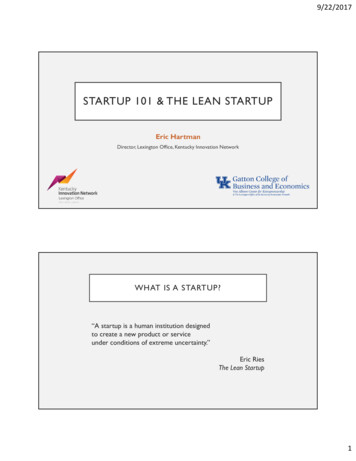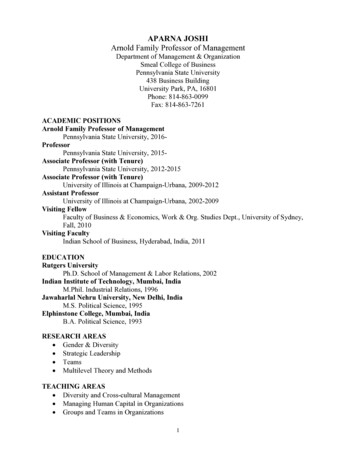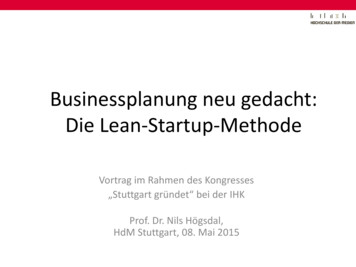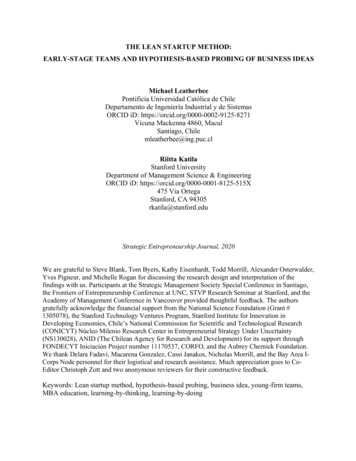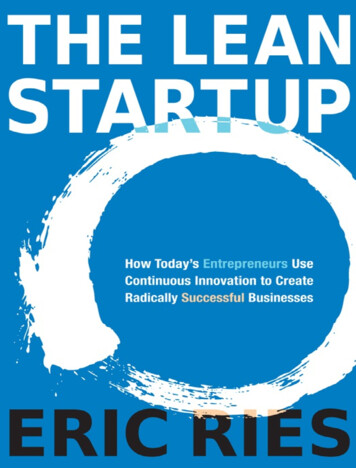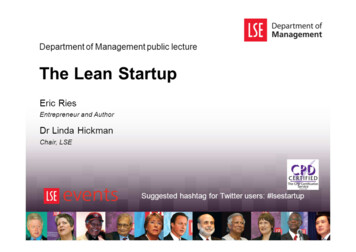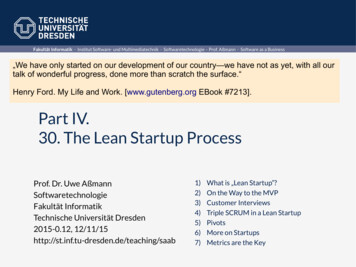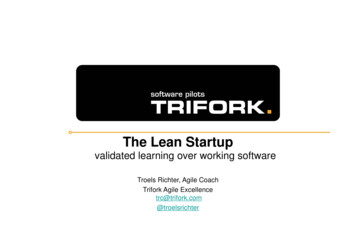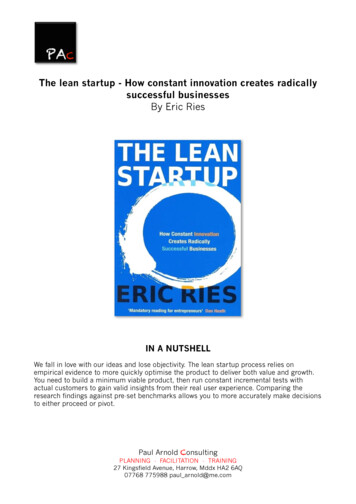
Transcription
The lean startup - How constant innovation creates radicallysuccessful businessesBy Eric RiesIN A NUTSHELLWe fall in love with our ideas and lose objectivity. The lean startup process relies onempirical evidence to more quickly optimise the product to deliver both value and growth.You need to build a minimum viable product, then run constant incremental tests withactual customers to gain valid insights from their real user experience. Comparing theresearch findings against pre-set benchmarks allows you to more accurately make decisionsto either proceed or pivot.Paul Arnold ConsultingPLANNING - FACILITATION - TRAINING27 Kingsfield Avenue, Harrow, Mddx HA2 6AQ07768 775988 paul arnold@me.com
THE BOOKBlinded - The harsh reality is most startups fail. Startups don’t starve - they drown (inhaving too many ideas). People fall in love with their ideas and can’t see their flaws.Furthermore, they do not know their audiences really well and critically how they relate totheir product. In many cases the fundamental product concept was flawed - people were notwowed enough to want it. Rarely is the original eureka moment of product innovation thefinal product. It takes a lot of optimising to take-off in a competitive market. Startups needto be disciplined to succeed. Thus at the heart of The Lean Startup (TLS) is data andmetrics.The author was the chief technical officer at IMVU (http://www.imvu.com). They broke all therules: they built a minimum viable product that was full of bugs; they charged money for it, andthey kept changing it. They talked to their customers but did not do what they said. Thisapproach of continuous innovation is now known as The Lean Startup (TLS) . By 2011, IMVUhad created more than 60m avatars with annual revenues of 50m.Key principles of The Lean Startup - Lean manufacturing is a process originated at Toyotato aid manufacturing. There are a number of key elements:1) Validated learning - The heart of TLS is the principle of running frequentexperiments to test each element of your concept until it has been honed to marketsuccess. All testing is aimed to rapidly learn what works/not works so to maximisethe effectiveness of an organisation’s scarce resources.2) Build-Measure-Learn - TLS encourages a rapid movement to a prototype (via aminimum viable product). Benchmarks are developed, then the product is put intomarket. The result either makes you persevere (continuing with incrementalimprovements) or pivot (i.e make seismic changes).3) UX - User experience is key as the way the customer uses your product could be verydifferent from how you think they will. No amount of cross transference of learningsfrom other markets or brands will be valid - only by going out and doing real researchon your market with your real consumers experiencing your product will you learnwhat is necessary for success in your specific market.At IMVU, feedback from users said they wanted their Avatars to move around. Thiswas a heavy technological ask so as an interim they gave them a limited functionalityto just click where they wanted their avatar to go and it would ‘teleport’ itself there.Surprisingly, users preferred this ‘magic’.4) Innovation accounting - TLS focuses on metrics - to remove as much subjectivity aspossible to lead to empirically based decision-making.5) Small Batch sizes - as small batch sizes allows more rapid learning and adaptation.When IMVU entered the instant messaging market they had a clear hypothesis aboutwhat led to success in the market. And so they developed a dummy product along thelines of their hypothesis. Even though it was very rough, they resisted the temptation tohold back and develop it further (for fear of tarnishing their image) and instead pushed itout into the market (as better to find out you are wrong early on than after masses ofPaul Arnold ConsultingPLANNING - FACILITATION - TRAINING27 Kingsfield Avenue, Harrow, Mddx HA2 6AQ07768 775988 paul arnold@me.com
product development). Their hypothesis was flawed, which led them to completelyrethink their positioning. Indeed it took them many iterations before they finally stumbledupon a positioning that they could exploit. It’s only by really seeing what people do ratherthan relying on our own flawed beliefs can we let go of our prejudices and blinkered view.Doing the right thing -There are many things to think about when setting up a company(e.g. sales, budget setting, recruitment etc etc) and doing all these things will make you feelyou have been effective in the day - but you could be spinning wheels - you could be doingthe wrong things efficiently because you still do not know who your customers are, what roleyour product plays, and if they will part with their money. TLS instead focuses on ensuringyou are building the right product - it starts with testing your hypothesis about yourproduct/concept with actual customers - as quickly as possible.The most important question any company should answer is ‘What activities add value andwhich are a form of waste?’ Thus you need to test every element on an almost continuousbasis to know which ones make a difference (and are worth pursuing) and which ones tostop wasting precious resources on (as most companies never had enough resources). Soinstead of building upon assumption, TLS relies on fact based evidence for each step viathe ‘Build-Measure-Learn’ feedback process. By constant experimentation, you can moveahead with greater certainty. And if you do need to make bigger shifts (known as pivots) youdo it much earlier on in the process, minimising wastage.Intuit flagship product, Turbotax undergoes 500 different ‘micro’ changes in a two and a halfmonth season. They will make a change on say a Thursday, run it over the weekend, read theresults on Monday, come to a conclusion on Tuesday, then rebuild and retest on Thursday.When you only do limited tests, you can only choose one or two variations, so there is a fightover whose ideas wins. when you can do 500 tests, then everyone’s ideas can get tested. Thisway, it’s not middle or upper management making the decisions - it’s the actual customers leading to more accurate (and timely) decision making. This speed has meant that they havedeveloped 50m revenue products in just 12 months instead of 5.5 years previously. By relyingon data it allows them to quickly kill things that do not add value and instead focus on refiningthe bits that do.Validated learning - Customers often do not know what they want. They find it difficult toenvisage something they have not had past experience of. So asking them in advance ofexperience is often flawed. However, when they gets their hands onto it, then they canprovide much greater clarity of response. One of the guiding principles of TLS is validatedlearning - it’s not what customers say that matters it’s what they do that is the empiricaltest of a product. Thus it’s key to give them a workable model of your product as soon as isfeasibly possible and then track what they do (or don’t do) with it.Waste vs value - A critical question TLS forces is to quickly distinguish between waste andvalue - i.e what adds value and what doesn’t (and hence is wasteful of resources). If afeature on a piece of software is not being used, then stop developing it. Instead use yourscarce resources to work on the parts they do add value. The sooner you know the valueitems, the less you will waste time doing the wrong things. Spend 12 months developing amore finished version and if it bombs, then you have wasted a year. Develop a version in 3months and if it bombs you have just wasted 3 months (and now have another 3 rounds toget it right). Thus the key principle is to learn fast (/fail fast).Paul Arnold ConsultingPLANNING - FACILITATION - TRAINING27 Kingsfield Avenue, Harrow, Mddx HA2 6AQ07768 775988 paul arnold@me.com
When IMVU were developing their instant messaging product they run hundreds of experimentsweek after week to discover what would inspire their customers to become advocates (‘netpromoter score’).Removing emotion and subjectivity - You need to be ruthlessly objective and not fall in lovewith your ideas. Set benchmarks and stick to them - you must face the hard truth of thedata - if the tests show it falls below benchmarks, then you need the strength to let go andchange.Buying success (too early) - Stakeholders may see all these endless negative test resultsas failure (which will make them lose faith). There is then the temptation to ‘buy’ artificialsuccess (e.g via marketing) but this will not lead to sustainable growth if the product isflawed. Furthermore it squanders limited resources which could have been better usedfurther developing and testing the product. So it’s best to resist the temptation toaccelerate growth before you have absolute certainty that you have a really powerful ideathat can maximise the marketing investment.The two driving factors for success: Value & Growth - Two critical questions to answerare: 1) The Value hypothesis - i.e. does your product or service really deliver value to yourcustomers? and 2) The Growth hypothesis - i.e. how far and how fast can the product/service grow? People find it very difficult to judge these two hypotheses in conceptual formso getting real market data is the only way to get validated data.In 2004, three college sophomore arrived in silicon valley with their fledging social medianetwork. With only 150,000 registered users it made little revenue, yet that summer they raised 500,000 in venture capital, and a year later another 12.7m. What made the Venturecapitalists buy into Facebook was not the revenue stream at that time but the fact the twohypotheses of value and growth had been clearly demonstrated. Value was proven by theamount of time people were spending on the site (each day, every day); and the growthhypothesis was validated by the fact that over 75% of all Harvard undergraduates usedFacebook within just 1 month of launch.Build-Measure-Learn - At the startup of a business, information is more important thanmoney because it is the critical element to success. Thus it’s imperative to learn quickly tohone the product quicker. The intent is to minimise the time it takes to circle round thisloop. The quicker you can do this, the faster you learn and the more you can learn (as youcan loop round more times, testing more elements).The B-M-L model has three phases: First a hypothesis is formed. Then the product isdeveloped that allows that hypothesis to be tested. Metrics/benchmarks are set to helpdetermine success criteria. Then the product is tested with real consumers. Their usagedata is then analysed against the benchmarks and these learnings drive decision-making.There are two routes to pursue - either to Proceed (if the results exceed the benchmarks) orPivot (if the results dramatically under perform expectations). By testing quicker it allowssome of these bigger ‘pivot’ decisions to be made faster and when it is easier to do (thanwhen you have a whole infrastructure set up to operate in a certain direction). Speed is acompetitive advantage. Learn to learn faster than your competition.Paul Arnold ConsultingPLANNING - FACILITATION - TRAINING27 Kingsfield Avenue, Harrow, Mddx HA2 6AQ07768 775988 paul arnold@me.com
The 5 Whys - To help isolate the real cause of a problem, use the 5 W’s technique (e.g. Whydid the machine stop? - Because X failed - Why did x fail? - Because Y happened - Whydid Y happen? etc. In most cases it often tracks back to a human problem. By doing thisyou save time in the long run (and is usually easier/quicker/cheaper to solve before theproblem escalates). The reality is that often a breakdown happens at a number of differentlevels so the 5 W’s creates a more robust solution as it picks up the errors at all the levels.Sadly in many organisations there seems to be more of a ‘5 blames’ culture. It needs toinstead be seen as a ‘collective failure’ rather than an individual (as everyone else shouldalso have spotted the problem). It’s recommended that teams tolerate mistakes first timeround (as most times it’s caused by flawed systems rather than bad people) but to learnfrom them and not let the same mistake happen twice.Genchi Gembutsu - ‘Go see for yourself’ (From Toyota) - you cannot be really sure youunderstand the problem unless you go see it for yourself first hand - it is unreliable to relyon other people’s reports. As Steve Blank once said, “Get out of the building and startlearning”.When they launched the 2004 version of the Sienna minivan, Toyota’s chief engineer on theproject took a 53,000 mile road trip across America, Canada and Mexico, talking to minivandrivers and their families. His big insight was that the kids rule the minivan and they are theone’s who need to be wowed. This led to an improved Sienna which had 60% higher sales thanthe previous model.When Intuit’s founder wanted to test his hypothesis that people would want to use computers tokeep track of their expenses and pay bills, he picked up two phone books, and randomly calledpeople to ask how they currently managed their finances. This cheap, quick and easy researchhelp validate his hypothesis enough to proceed onto the next stage. It was not in-depth,checking out lots of potential options and pricing structures, but a quick piece of researchfocused on one key research question (all too often research becomes over complicated).Minimum Viable Product (MVP) - To move rapidly through each cycle needs a product andthis is what usually steals the time. Instead TLS relies on MVP’s - Minimum viable products- i.e the rawest, quickest (cheapest) version that delivers the core functionality that is beingtested (all the other bells and whistles, and glossy packaging are not developed at thisstage as it takes time and detracts from what is being tested). It’s not meant to be 100%accurate - it’s meant to be the start of learning not the end of it. Whilst such small scaletesting has its weaknesses, this is compensated by real in-market insights gained withpeople actually using your product. The secret of an MVP is to keep it as simple aspossible.Nick Swinmurn, the founder of Zappos, the online shoe retailer (worth in excess of 1bn)wanted to test his hypothesis that people would be prepared to buy shoes online. Rather thanbuilding up a warehouse full of shoes, he went to a local shoe store, took photos of their shoes,and posted their pictures on-line in a simple website. When customers clicked to buy, he wouldsimply go back to the shoe store, buy the shoes and ship them out - thus holding no stock andno risk. This ‘cheap’ piece of research validated his hypothesis and helped him learn his way tosuccess. What was critical was he had real behaviour data (not hypothetical ‘If we set up awebsite selling shoes would you buy from us?’ type spurious data). It also quickly taught himthings he never really thought too much about such as discounting and returns policy.Paul Arnold ConsultingPLANNING - FACILITATION - TRAINING27 Kingsfield Avenue, Harrow, Mddx HA2 6AQ07768 775988 paul arnold@me.com
VLS wanted to see if there was a market for laundrettes in India. Rather than commissioninglarge scale research, they mounted an industrial size washing machine on the back of a pick uptruck and parked it on a street corner in Bangalore - the experiment cost less than 8,000 andproved that people would pay to have their clothes cleaned. They parked it on different streetcorners and experimented with different elements to answer different questions - such as speedand extra services like ironing. VLS now have14 locations in India.Groupon is one of the fastest growing companies of all times. The very first deal was 20 peoplebuying a two-for-one deal on a pizza. Their first minimum viable product was a WordPress blogsite where they sold T shirts. They had no on-line ordering mechanism so people had to emailtheir order in. Now they are operating in more than 375 cities worldwide.Sometimes it’s not possible to make the product - in which case trying to bring it alive as muchas possible is the next best thing. When Dropbox was first being developed, it used a video toexplain how to use Dropbox. This helped drive up the number of people prepared to take part inthe beta tests from 5,000 to 75,000.Food On The Table creates weekly meal plans for families based on their choices and the bestdeals on local ingredients. To first test their assumptions, they signed-up just one family andpersonally developed the food plans for them by visiting all their local stores. Clearly this wasvery costly in time but gave them invaluable learnings on the good and bad points of theiroffering.Aardvark (a search engine to answer the questions Google can’t) initially tested their conceptusing people not technology to mimic the search engine functionality (because they knew itwas not until they had validated their value and growth hypotheses should they start investing inthe technology).Quality levels at different life stages - The value of quality is target audience specific i.e.early adopters appear to be very forgiving of beta MVP’s (they like being at the forefront).So you can get away with an MVP at the start but once validated, then the product needs tobe optimised for quality to appeal to new (less forgiving) audiences. For many mainstreammarketers, the idea of putting out a substandard product is counter-intuitive as they see itdamaging their brand reputation.Innovation Accounting - Many brands stumble along in the zone of the ‘living dead’ - neverquite taking off. The trouble with most people is they are naturally optimistic and assume 1)their product is brilliant and 2) things will get better. Entrepreneurs need to park theirnatural enthusiasm and face the harsh facts that proper financial accounting will testify to.Innovation Accounting has three steps: 1) Use an MVP to establish a data baseline of whereyour company is right now 2) You then fine tune the ‘engine’ to move up from the baseline3) If you do, then ‘Persevere’. If not then ‘Pivot’.A key question to always ask is ‘How do you know if you are making your product better?’The answer must be empiric. Metrics need to be actionable, accessible and auditable (i.e.credible).At IMVU, they had monthly meetings where they reported back on a range of metrics such asregistration rates, download rates, trial rates, repeat usage rates, conversion to purchase rates,Paul Arnold ConsultingPLANNING - FACILITATION - TRAINING27 Kingsfield Avenue, Harrow, Mddx HA2 6AQ07768 775988 paul arnold@me.com
customer counts and revenue. Even though they had been busy refining and changing theproduct, the bottom line metrics showed no shift - i.e. all their effort was not generating anyreturn. The harsh reality of flat numbers made them re-look at everything they were doing. Thisled them to pivoting the product. If the company had not set clear benchmarks they could easilyhave carried on down this track for another year - and eventually into oblivion.Beware ‘vanity metrics’ - It’s also key to make sure you look at the right kind of metrics(some give you a nice warm feeling and others put money in the bank). Cohort analysisgives a better reflection than cumulative total (which fool you into a space of positivity asthe numbers grow each day), but with cohort analysis you just look at the behaviour trendsof the latest 100 customers - and if they are not converting at a higher rate, then yourproduct is not getting better. So avoid ‘vanity metrics’ and instead focus on ‘actionable’metrics.Grockit’s founder Farbood Nivi knew student to student peer based learning was effective. Hesaw the opportunity to use ‘social learning’ to develop it globally. So he designed a minimumviable product (i.e. an online video). Having validated his value and growth hypotheses, he wasable to raise venture capital and embarked on developing his product. The trouble was initiallythey were relying on vanity metrics (such as total number of customers). Soon he switched tocohort analysis and using A/B testing was able to make rapid, effective progress.‘Persevere’ or ‘Pivot’ - It takes courage and discipline to let go on your original beliefsabout your product and change (that’s why you need to rely on data to overcome our inbuiltresistance). But the longer you leave it, the greater the costs.When the numbers exceed your benchmark, then your hypothesis has been supported andyou can ‘persevere’, continuing to refine along the same lines. When the results are wellbelow benchmark, you need to shift the product or strategy to continue to meet the setvision. The faster you can pivot and learn, the greater the chance of taking off (before yourun out of money).KaChing first started off as an online game for amateur investors where they played the marketbut in a fantasy league. Their real aim was to use it to identify future traders and for those lesssuccessful traders, to offer them trading by those who did perform well. This meant they built upa sophisticated scoring system for each player to evaluate their investment prowess. Howevertheir strategy did not work, so they pivoted, abandoning the gaming option (and throwing awaymonths of work) and instead allowing people to invest with professional managers who hadbeen assessed through their tool. Today Wealthfront has over 180m invested with more than40 professional managers.The pivot is about optimising the product to market fit. When this happens, you getbusiness traction. There are 10 kinds of pivot:1) Zoom-in pivot: Where focus-in on one specific feature of the product2) Zoom-out pivot: Where the original focus on a single feature gets subsumed into a wideroffering3) Platform pivot: A shift from just one product to a range of offerings4) Customer need pivot: Where you solve a different problem for the same customer5) Customer segment pivot: A shift in who the customer focus is6) Business Architecture pivot: A major shift on the strategy for financial growth (e.g. a shiftfrom low volume/high margin to high volume/low margin)Paul Arnold ConsultingPLANNING - FACILITATION - TRAINING27 Kingsfield Avenue, Harrow, Mddx HA2 6AQ07768 775988 paul arnold@me.com
7) Value capture pivot: How it moneterises itself8) Engine of growth pivot: How it changes its engine of growth (e.g. from viral or sticky topaid growth)9) Channel pivot: Moving to a new distribution channel10) Technology pivot: Finding a new way of delivering the same benefitBatch size - If you stuff a series of envelopes, seal them, and put a stamp on them, itmakes intuitive sense to do each operation in turn - i.e. stuff them all, then seal them all,then stamp them all. But research has shown that it’s faster to instead complete eachenvelope one at a time. In business, it saves time by identifying problems early on. Forexample, if the envelope’s seal is faulty, then it’s better to find that out early on (otherwiseyou have to unpack all the envelopes). So it is in manufacturing. Toyota adopted small batchsizes to offer a competitive advantage (of variety.) This was made possible by reducing thechangeover time from hours to minutes (SMED - Single minute exchange of die).Furthermore they adopted the Andon cord principle where anyone can stop the productionline to resolve a problem. It might slow things down initially but stops recalls/refits later on.Increasingly software updates are delivered one update at a time - almost on a continual basis(IMVU can make up to 50 mini changes a day). They then use matrix teams to work on onefeature at a time. They then get single issue feedback that provides immediate and focusedfeedback.For many industries they may assume these principles cannot apply to their business. Butincreasingly we are seeing software providing added functionality to hardware (from cars tofridges to sportswear), and increased customisation of products (e.g. BMW, Nike etc).SGW Designworks were asked to build a complex field x-ray system to detect explosives. Theydelivered their first 3D model within 3 days. Their clients made a few amends and the finaldesign with a new mock-up was agreed 5 days later. 40 production units were made just threeand a half weeks after initiation of the project. SGW used the same process to deliver 8 otherproducts in a 12 month period.In the ‘school of one’ students are given a daily personalised ‘playlist’ of their learning tasks.This may be a mix of small group work, e-learning, one-on-one tutoring time or personal studytime. Each activity has built-in feedback mechanisms to help set future activities.The myth of large batch sizes - Large batch sizes feels intuitively right, and so you quicklyget into large batch death spiral - fix one more bug.wait another week and we have thatnew feature. The trouble is the longer you leave something the more perfect you feel itneeds to be.When Apple launched its long awaited iPhone 4, it had 1500 changes in one batch.Adapt - With this speed of learning, an organisation needs to adapt fast enough to thechanges required. It’s best to operate in smaller matrix teams, who are empowered to makefast and courageous decisions (through faster customer feedback).Paul Arnold ConsultingPLANNING - FACILITATION - TRAINING27 Kingsfield Avenue, Harrow, Mddx HA2 6AQ07768 775988 paul arnold@me.com
Complex systems need simple rules (not complex ones) to navigate through - thusprinciples rather than detailed processes are better - hence Learn (/Fail) fast, MVP, Smallbatch sizes etc are all sound principles of a more efficient way of working.CRITICISMSThis book is quite an influential book doing the rounds at present. It has some strong coreconcepts that can be applied in many areas of business.That said, I question whether The Lean Startup principles can be applied to all businessesor launches (nothing in my experience is that perfect a system). I think he overemphasisesthe difference between TLS and normal business. In my experience every brand I have everworked on does a lot of concept/product testing to hone its offering and to understandabout its customer.One of the problems of this model is the trouble in setting accurate benchmarks and thiscan then lead to flawed decision-making. Building from this the TLS model is very ‘metrics’driven. We can also be misled by numbers as we can be misled by emotions. Numbers tendto take a singular focus when we live in a place of mass complexity. I therefore believe weneed to take the numbers as a guide but then make a more rounded decision taking intoaccount other factors that numbers can’t help map.Paul Arnold ConsultingPLANNING - FACILITATION - TRAINING27 Kingsfield Avenue, Harrow, Mddx HA2 6AQ07768 775988 paul arnold@me.com
Uncovering the power and magic ofthe brand 5on%pla;orm.%Paul Arnold ConsultingPLANNING - FACILITATION - TRAINING27 Kingsfield Avenue, Harrow, Mddx HA2 6AQ07768 775988 paul arnold@me.com
The lean startup - How constant innovation creates radically successful businesses By Eric Ries IN A NUTSHELL We fall in love with our ideas and lose objectivity. The lean startup process relies on empirical evidence to more quick
